Of all the wolves in the world, the gray wolf has many subspecies, some extinct, others still roaming the Earth. But how much does a wolf weigh? With their many differences across characteristics and the environments they call home, time and evolution have significantly impacted their sizes.
As we explore the subspecies of gray wolf that is not yet extinct, we will uncover the wide variety of wolf weights categorized by age and gender.
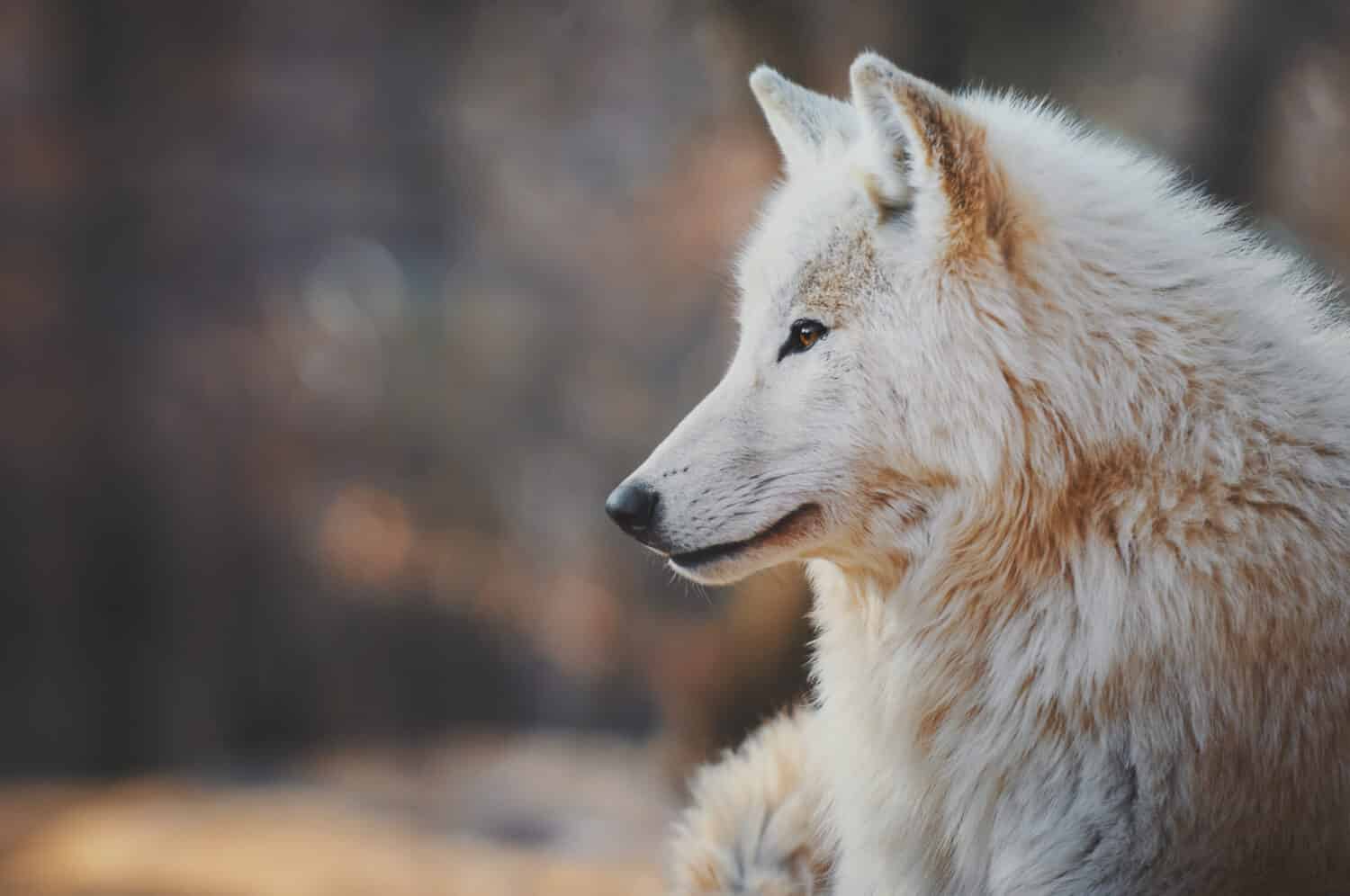
The
Arctic Wolf
is a subspecies of gray wolf.
©JDzacovsky/Shutterstock.com
The Gray Wolf Subspecies
As the largest member of the Canidae family, the gray wolf (Canis lupus) stands as a potent symbol of wilderness, a revered creature of power and mystery in many cultures, and, unfortunately, a target of fear and misunderstanding in others. This majestic animal has a global presence that ranges across North America, Europe, Asia, and with evidence of recent sightings, now Africa. Moreover, in this exploration, we delve into the varied weights of subspecies of the gray wolf, offering a detailed glimpse into the geographical distribution and unique characteristics of these creatures.
The gray wolf’s population once covered vast swaths of land. However, it has significantly diminished due to various anthropogenic factors. As of 2023, roughly 25 subspecies of the gray wolf are not yet extinct. Though the exact number of the gray wolf subspecies, whether extinct or not, is debated amongst taxonomists, the total subspecies is roughly 38.
This article will explore 25 subspecies of the gray wolf that are still roaming the Earth, including their average weight and other defining characteristics.
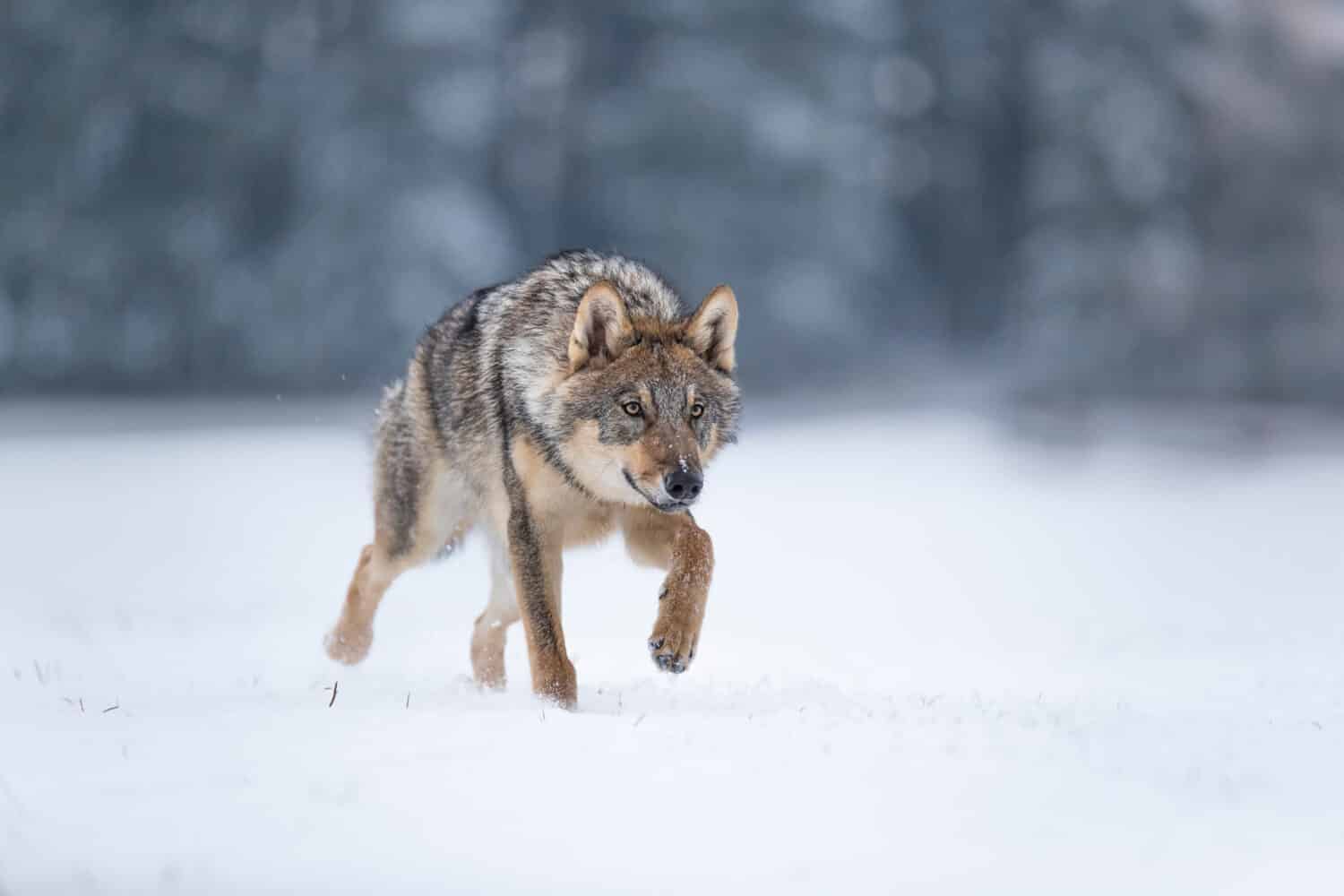
The weight of wolves varies greatly by subspecies.
©Vlada Cech/Shutterstock.com
Alaskan Tundra Wolf (Canis lupus tundrarum)
The Alaskan Tundra Wolf, Canis lupus tundrarum, is a subspecies native to the northern coastal regions of Alaska. Furthermore, they thrive within the harsh arctic tundra, blending seamlessly into their snowy environment with their white and gray coats. One notable characteristic of this subspecies is its size, with adults reaching weights upwards of 150 pounds (68 kilograms). Their larger build, compared to other subspecies, is believed to be an adaptation to tackle larger prey such as caribou and muskox, ensuring their survival in the arctic wilderness.
Great Plains Wolf (Canis lupus nubilus)
The Great Plains Wolf is a subspecies that once boasted a vast territory across North America’s Great Plains, ranging from southern Manitoba in Canada to northern Texas in the United States. An adaptable and resilient creature, the Great Plains wolf could survive in various environments, from prairies to forests. Adult Great Plains wolves typically weigh between 64 to 110 pounds (29 to 50 kilograms), making them slightly smaller than their Alaskan counterparts but no less formidable.
Alaskan Interior Wolf (Canis lupus pambasileus)
The Alaskan Interior Wolf claims the interior regions of Alaska and western Yukon in Canada as its home. Of all the gray wolf subspecies, this one stands among the largest. Adult males often exceed 100 pounds (45.4 kg), with few individuals even reaching beyond 145 pounds (65.7 kilograms). Moreover, their size gives them an advantage in hunting large prey like moose and caribou, a critical factor for survival in these vast, remote wilderness areas.
Greenland Wolf (Canis lupus orion)
The Greenland Wolf makes its home in the northeastern part of Greenland, a remote and harsh location that has afforded this subspecies limited human contact. Furthermore, this subspecies has adapted to and thrived in one of the world’s harshest climates. Although specific weight details are limited due to the remote habitat, Greenland wolves are considered smaller than average, with estimated weights of around 45 to 75 pounds (20.4 to 34 kilograms).
Northwestern Wolf (Canis lupus occidentalis)
The Northwestern Wolf enjoys a broad range, extending from Alaska through Western Canada and into parts of the northwestern United States. This subspecies, critical to wolf reintroduction programs in places like Yellowstone National Park, typically have adult weights ranging from 80 to 150 pounds (36.3 to 68 kilograms), with males generally larger than females.

The Eurasian Wolf is one of the largest wolf subspecies, weighing upwards of 150 pounds or more.
©AB Photographie/Shutterstock.com
Baffin Island Wolf (Canis lupus manningi)
Baffin Island is home to a wolf subspecies less known than its mainland counterparts. This subspecies is unique for its adaptation to the island’s intense climate, characterized by smaller size and denser fur. The Baffin Island Wolf tends to weigh less than their mainland relatives due to their location and evolution, with average weights for adults estimated to be around 30 to 50 pounds (13.6 to 22.7 kilograms).
Mackenzie River Wolf (Canis lupus mackenzii)
You can find the Mackenzie River Wolf around the Mackenzie River valley in Canada. This subspecies plays an integral role in maintaining the ecological balance of its habitat by controlling the population of large ungulates. Moreover, the Mackenzie River Wolf is quite large, with adults typically weighing between 85 to 150 pounds (38.5 to 68 kilograms).
Eastern Wolf (Canis lupus lycaon)
The Eastern Wolf is native to the eastern regions of North America, specifically around the Great Lakes area and southeastern Canada. This subspecies has been the subject of an ongoing debate in the scientific community regarding its taxonomy, with some researchers suggesting it may be a distinct species rather than a subspecies of the gray wolf. The Eastern Wolf tends to be smaller than their Western counterparts, with adult weights typically ranging from 48 to 70 pounds (21.8 to 31.8 kilograms).
Alexander Archipelago Wolf (Canis lupus ligoni)
The Alexander Archipelago Wolf is a distinct subspecies native to the islands of southeastern Alaska. This subspecies has a dark coat and is a skilled hunter of the local Sitka Deer. Furthermore, its smaller size, averaging around 30 to 50 pounds (13.6 to 22.7 kilograms), is an adaptation to its island habitat, allowing for more efficient hunting and mobility. Interestingly, these wolves are known for their tightly-knit pack structure. They often work in unison when hunting prey or protecting their territory.
Labrador Wolf (Canis lupus labradorius)
The Labrador Wolf is a denizen of the Labrador region of Canada. Distinguished by a dense, light-colored coat, this wolf subspecies primarily prey on caribou. Adult weights vary significantly across populations, generally between 64 to 100 pounds (29 to 45.4 kilograms). Intriguingly, the Labrador Wolf shows high social cooperation when hunting large prey, often utilizing complex strategies and division of roles within the pack.
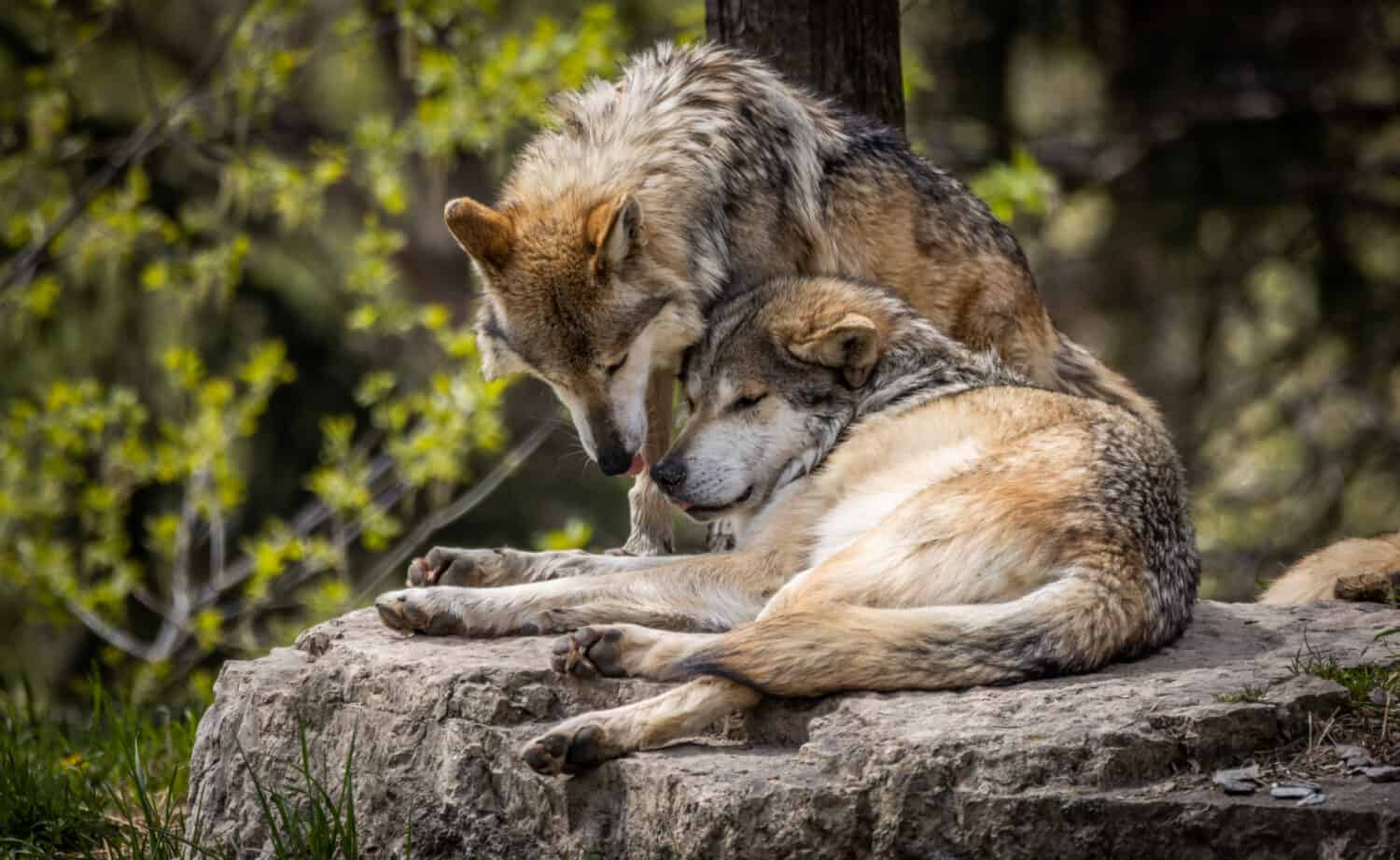
The Mexican Wolf weighs roughly 50 to 80 pounds.
©Luke23/Shutterstock.com
Northern Rocky Mountain Wolf (Canis lupus irremotus)
You can find the Northern Rocky Mountain Wolf in the northern region of the Rocky Mountains. This subspecies is recognized for its adaptability, thriving in varied terrains and altitudes. Adult wolves of this subspecies weigh between 70 to 150 pounds (31.8 to 68 kg). Furthermore, they are known for their endurance and ability to travel long distances in pursuit of prey, a trait essential in the rugged landscapes of the Rockies.
Hudson Bay Wolf (Canis lupus hudsonicus)
Inhabiting the area around Hudson Bay in Canada, the Hudson Bay Wolf stands out with its slightly smaller size and thicker coat, adaptations necessary for survival in its colder environment. Moreover, the adult Hudson Bay Wolf weighs between 80 to 140 pounds (36.3 to 63.5 kilograms). Amazingly, these wolves have shown resilience in the face of the extreme Arctic winters, using their superior senses and cooperative hunting strategies to find food.
Vancouver Island Wolf (Canis lupus crassodon)
The Vancouver Island Wolf is a subspecies exclusive to Vancouver Island off Canada’s west coast. Moreover, it distinguishes itself with its smaller size and darker fur, blending into the island’s dense forests. The adult Vancouver Island Wolf typically weighs between 44 to 90 pounds (20 to 40.8 kilograms). Finally, these wolves’ diet consists mainly of marine animals, exhibiting their unique adaptation to their island environment.
British Columbian Wolf (Canis lupus columbianus)
The British Columbian Wolf roams the mainland coast and islands of British Columbia. Celebrated for their impressive hunting skills, they predominantly prey on moose and deer. The adult British Columbian Wolf weighs between 80 to 150 pounds (36.3 to 68 kilograms). Furthermore, they are highly communicative within their packs. In addition, they demonstrate a high social structure, with alpha pairs leading the pack and complex communication patterns observed.
Mexican Wolf (Canis lupus baileyi)
The Mexican Wolf inhabits areas of Mexico and the southwestern United States. Once on the brink of extinction, this subspecies has slowly recovered thanks to dedicated conservation efforts. Smaller than other North American wolf subspecies, the Mexican Wolf typically weighs between 50 to 80 pounds (22.7 to 36.3 kilograms). Their comeback story is a testament to the impact and importance of conservation efforts.
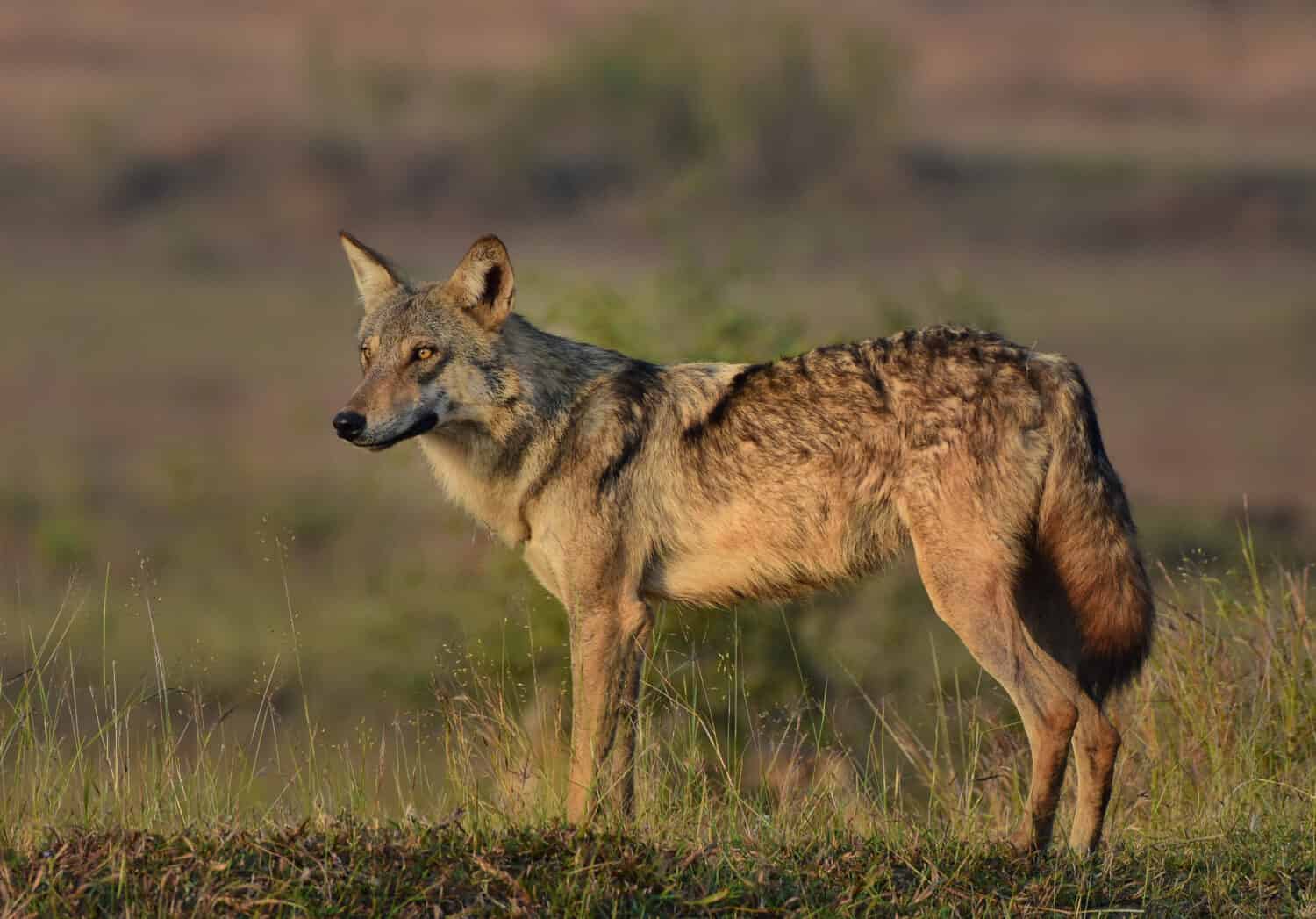
The Indian Wolf is a much smaller wolf, with a weight estimate of 34 to 55 pounds.
©wildlife by yusuf/Shutterstock.com
Arctic Wolf (Canis lupus arctos)
The Arctic Wolf thrives in the harsh conditions of the Arctic regions of North America and Greenland. Adapted to the intense cold, it possesses a thicker coat and shorter ears and muzzle compared to other subspecies. The adult Arctic Wolf typically weighs between 70 to 150+ pounds (31.8 to 68 kilograms), making them one of the largest wolf subspecies. Moreover, few males reach upwards of 175 pounds or more. Remarkably, they can endure temperatures as low as -30 degrees Celsius, showcasing their remarkable adaptation to the Arctic environment.
Iberian Wolf (Canis lupus signatus)
A resident of the Iberian Peninsula in Spain and Portugal, the Iberian Wolf is distinguishable by a dark, vertical stripe across its muzzle and light markings on its tail. Their weights range from 61 to 120 pounds (27.7 to 54.4 kilograms). Unlike their relatives who prefer larger prey, the Iberian Wolf has adapted to a diet of smaller creatures, including rabbits and roe deer. Additionally, they are known to be incredibly elusive and wary of human interaction, making them one of the lesser-known wolf subspecies.
Indian Wolf (Canis lupus pallipes)
The Indian Wolf, hailing from the Indian Subcontinent, is a smaller wolf, with adults weighing between 34 to 55 pounds (15.4 to 25 kilograms). Their thinner coat, adapted to the warmer climate, is generally tawny to reddish-white. Notably, their packs are smaller, often comprising of a pair and their pups, and they have a more solitary lifestyle than other wolves. These wolves are also culturally significant in many parts of India, featuring in several folk tales and tribal traditions.
Eurasian Wolf (Canis lupus lupus)
Roaming across the diverse landscapes of Europe and Asia, the Eurasian Wolf is a remarkably adaptable subspecies. Moreover, with an adult weight range of 64 to 150+ pounds (29 to 68 kilograms), these wolves have the most diverse diet among wolves, consuming a variety of prey from small rodents to large ungulates. Furthermore, few males reach beyond 175 pounds or more. Finally, they are known for their resiliency and adaptability, able to thrive in a range of habitats from the cold Siberian tundra to the forests of Western Europe.
Italian Wolf (Canis lupus italicus)
Found in the Apennine Mountains in Italy, the Italian Wolf is a medium-sized subspecies weighing 52 to 99 pounds (23.6 to 44.9 kilograms). Furthermore, they are known for their slender build and light-colored fur, they rebounded from near extinction in the 1970s, becoming a symbol of successful conservation efforts. Most notably, the Italian Wolf has been subject to numerous studies investigating its behavior, ecology, and interaction with human populations.
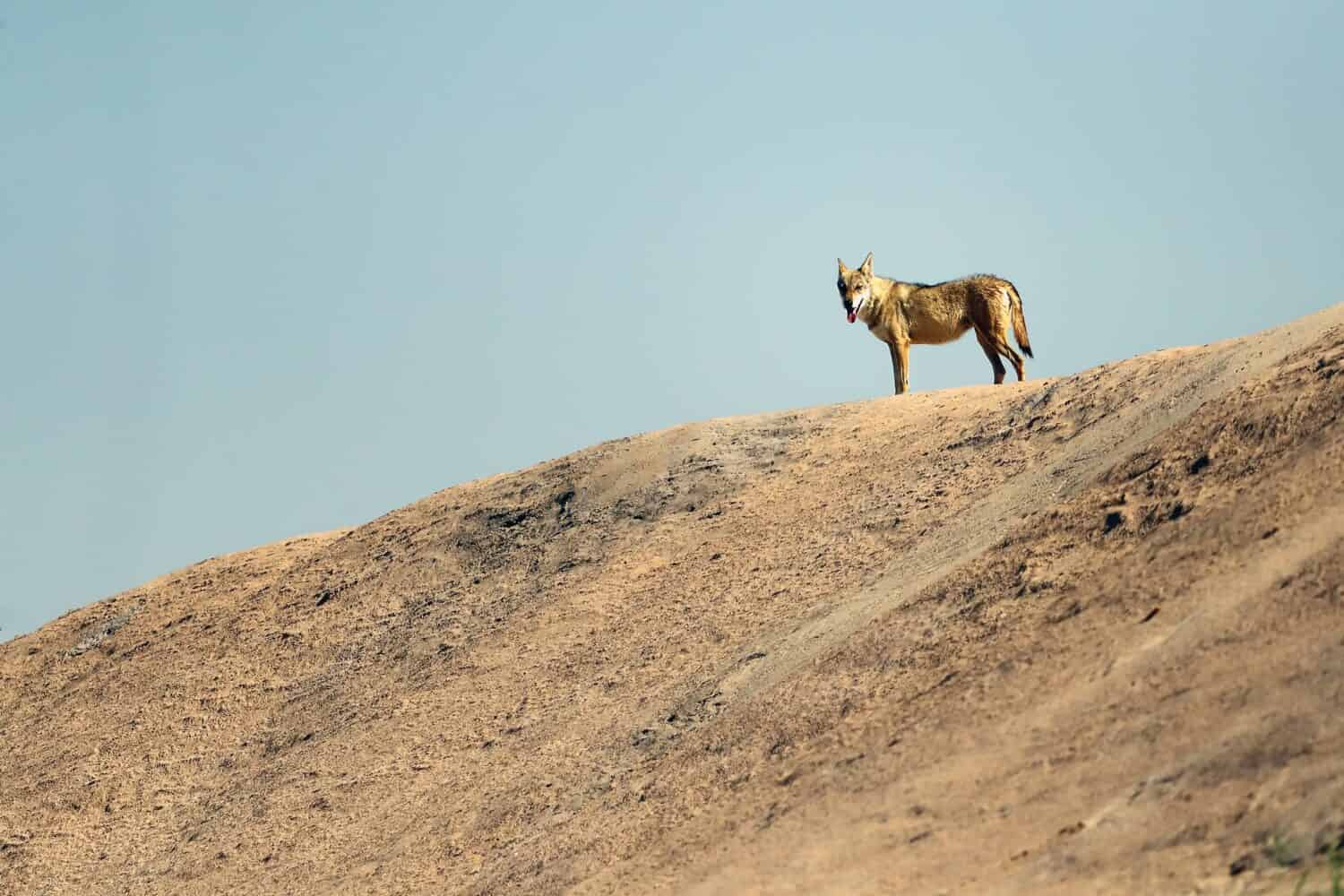
The Arabian Wolf weighs roughly 28 to 48 pounds.
©Karel Bartik/Shutterstock.com
Dingo and New Guinea Singing Dog (Canis lupus dingo)
These canids, from Australia and New Guinea, respectively, are unique. Furthermore, weighing an average of 24 to 40 pounds (10.9 to 18.1 kilograms), they are known for their distinctive and melodious howl that can change pitch, giving the New Guinea Singing Dog its name. Both animals are adaptable and can thrive in various habitats, from forests to deserts.
Mongolian Wolf (Canis lupus chanco)
Native to Mongolia and Central Asia, the Mongolian Wolf or Himalayan Wolf, with its average weight of 65 to 130 pounds (29.5 to 59 kilograms), is well-adapted to the arid and cold steppe environment. Moreover, an integral part of the region’s ecosystem, these wolves are primarily hunters of ungulates, with a preference for gazelles and wild Bactrian camels. Furthermore, these wolves possess beautiful thick coats ranging in color from cream to reddish-brown. They are well-adapted to the harsh, cold environments they inhabit.
Steppe Wolf (Canis lupus campestris)
You can find the Steppe Wolf in the grasslands of Central Asia. They feature a thick coat to protect against the cold winters. In addition, the adult Steppe Wolf typically weighs 68 to 95 pounds (30.8 to 43 kilograms). Finally, known for their nomadic lifestyle, they travel vast distances in pursuit of prey, consuming a diverse diet that includes everything from small rodents to larger ungulates.
Arabian Wolf (Canis lupus arabs)
The Arabian Wolf is native to the Arabian Peninsula, including regions of Saudi Arabia, Jordan, and Oman. Furthermore, as a smaller subspecies, it typically weighs between 28 to 48 pounds (12.7 to 21.8 kilograms). Moreover, with a sandy-colored coat, this wolf adapted to its range’s arid and desert environments. The Arabian Wolf is an essential component of the ecosystem, playing a role in controlling populations of prey species such as gazelles and ibex. It is also known for its ability to withstand extreme temperatures and water scarcity, making it highly resilient in its challenging habitat.
Tundra Wolf (Canis lupus albus)
The Tundra Wolf inhabits the vast Arctic tundra regions of the world, including parts of Alaska, Canada, Greenland, and northern Europe. Furthermore, with an average weight ranging from 68 to 110 pounds (30.8 to 49.9 kilograms), these wolves adapted to the harsh conditions of the tundra, where temperatures can plummet and food resources are limited. Moreover, they have a dense, white, or light gray coat that provides camouflage in the snowy landscape. Meanwhile, the Tundra Wolf is known for its wide-ranging movements in search of prey, including muskoxen, caribou, and Arctic hares. Finally, these wolves have a crucial role in maintaining the balance of the Arctic ecosystem.

The Hudson Bay Wolf is a larger wolf subspecies weighing 80 to 140 pounds on average.
©jindrich_pavelka/Shutterstock.com
Ongoing Conservation Efforts Are Needed to Protect Wolves
In each of their respective habitats, each gray wolf subspecies play a crucial role as an apex predator. They contribute to a balanced ecosystem by keeping herbivore populations in check and consequently preventing overgrazing, which can lead to soil erosion and other negative environmental impacts.
In addition, the gray wolf subspecies exhibit diverse physical characteristics, behaviors, and adaptations corresponding with their varied habitats. However, the threats they face remain strikingly similar across regions. Habitat loss, persecution due to human-wildlife conflict, and inbreeding due to isolated populations are challenges common to almost all subspecies.
While the gray wolf as a species and its many subspecies continue to face these daunting threats, hope exists. Moreover, reintroduction programs, legislation, and increased public awareness offer promising avenues for their recovery. However, there needs to be more action to ensure these majestic creatures continue to howl in our wild spaces for generations to come.

Of the remaining wolf subspecies, their weights are influenced by diet, environment, and genetics.
©AB Photographie/Shutterstock.com
How Much Does a Wolf Weigh?
The weights of wolves can greatly vary due to several factors, such as genetics, environment, and diet. Generally, the weight distribution considers the following. On average, for the gray wolf species, pups can weigh roughly one to two pounds at birth. During adolescence, they are 60 to 80% of their adult weight. Adult female weight is around 80-85% of the adult male weight. And finally, the adult male weight varies greatly from each subspecies of the gray wolf.
Furthermore, in the table below, let’s look at the average adult male weight and estimated pup, adolescent, and female weights.
Weight of Each Gray Wolf Subspecies
| Gray Wolf Subspecies | Estimated Weight of Four-Week-Old Pup | Estimated Weight of Adolescent | Estimated Weight of Adult Female | Average Weight of Adult Male | Average Body Length of Adult |
|---|---|---|---|---|---|
| Alaskan tundra Wolf (Canis lupus tundrarum) | 12 to 30 pounds | 48 to 120 pounds | 80 to 128 pounds | 100 to 150+ pounds | 4.5 to 7 feet |
| Great Plains Wolf (Canis lupus nubilus) | 9 to 22 pounds | 51 to 88 pounds | 64 to 94 pounds | 80 to 110 pounds | 4.5 to 6.5 feet |
| Alaskan Interior Wolf (Canis lupus pambasileus) | 9 to 23 pounds | 40 to 104 pounds | 68 to 110 pounds | 85 to 130 pounds | 5 to 6.5 feet |
| Greenland Wolf (Canis lupus orion) | 6 to 15 pounds | 27 to 60 pounds | 45 to 63 pounds | 57 to 75 pounds | 4 to 5 feet |
| Northwestern Wolf (Canis lupus occidentalis) | 12 to 30 pounds | 48 to 120 pounds | 80 to 127 pounds | 100 to 150 pounds | 5 to 7 feet |
| Baffin Island Wolf (Canis lupus manningi) | 4 to 10 pounds | 18 to 40 pounds | 30 to 43 pounds | 40 to 50 pounds | 3 to 3.5 feet |
| Mackenzie River Wolf (Canis lupus mackenzii) | 13 to 30 pounds | 51 to 120 pounds | 85 to 127 pounds | 106 to 150 pounds | 5 to 5.5 feet |
| Eastern Wolf (Canis lupus lycaon) | 7 to 14 pounds | 29 to 56 pounds | 48 to 60 pounds | 60 to 70 pounds | 3 to 5.25 feet |
| Alexander Archipelago Wolf (Canis lupus ligoni) | 4 to 10 pounds | 18 to 40 pounds | 30 to 43 pounds | 40 to 50 pounds | 3 to 3.5 feet |
| Labrador Wolf (Canis lupus labradorius) | 8 to 20 pounds | 38 to 80 pounds | 64 to 85 pounds | 75 to 100 pounds | 4.5 to 6 feet |
| Northern Rocky Mountain Wolf (Canis lupus irremotus) | 10 to 30 pounds | 42 to 120 pounds | 70 to 127 pounds | 88 to 150 pounds | 3.5 to 5.5 feet |
| Hudson Bay Wolf (Canis lupus hudsonicus) | 12 to 28 pounds | 48 to 112 pounds | 80 to 119 pounds | 100 to 140 pounds | 4 to 5 feet |
| Vancouver Island Wolf (Canis lupus crassodon) | 7 to 18 pounds | 27 to 72 pounds | 44 to 76 pounds | 56 to 90 pounds | 4 to 5 feet |
| British Columbian Wolf (Canis lupus columbianus) | 12 to 30 pounds | 48 to 120 pounds | 80 to 128 pounds | 100 to 150 pounds | 4.75 to 6 feet |
| Mexican Wolf (Canis lupus baileyi) | 7 to 16 pounds | 30 to 64 pounds | 50 to 68 pounds | 63 to 80 pounds | 4 to 5.5 feet |
| Arctic Wolf (Canis lupus arctos) | 10 to 30 pounds | 42 to 120 pounds | 70 to 127 pounds | 88 to 150+ pounds | 3.25 to 6 feet |
| Iberian Wolf (Canis lupus signatus) | 9 to 24 pounds | 37 to 96 pounds | 61 to 102 pounds | 77 to 120 pounds | 4.5 to 5.75 feet |
| Indian Wolf (Canis lupus pallipes) | 5 to 11 pounds | 20 to 44 pounds | 34 to 47 pounds | 42 to 55 pounds | 3.5 to 4.75 feet |
| Eurasian Wolf (Canis lupus lupus) | 10 to 30 pounds | 38 to 120 pounds | 64 to 127 pounds | 80 to 150+ pounds | 3.5 to 5.75 feet |
| Italian Wolf (Canis lupus italicus) | 8 to 20 pounds | 31 to 79 pounds | 52 to 84 pounds | 65 to 99 pounds | 3.5 to 5 feet |
| Dingo and New Guinea Singing Dog (Canis lupus dingo) | 3 to 8 pounds | 14 to 32 pounds | 24 to 34 pounds | 30 to 40 pounds | 1.5 to 2 feet |
| Mongolian Wolf (Canis lupus chanco) | 10 to 26 pounds | 39 to 104 pounds | 65 to 110 pounds | 82 to 130 pounds | 3.5 to 6 feet |
| Steppe Wolf (Canis lupus campestris) | 10 to 19 pounds | 40 to 76 pounds | 68 to 80 pounds | 85 to 95 pounds | 3.5 to 5 feet |
| Arabian Wolf (Canis lupus arabs) | 4 to 10 pounds | 17 to 38 pounds | 28 to 40 pounds | 35 to 48 pounds | 1.5 to 2 feet |
| Tundra Wolf (Canis lupus albus) | 10 to 22 pounds | 40 to 88 pounds | 68 to 94 pounds | 85 to 110 pounds | 3.5 to 4.5 feet |
The photo featured at the top of this post is © Vlada Cech/Shutterstock.com
Thank you for reading! Have some feedback for us? Contact the AZ Animals editorial team.






